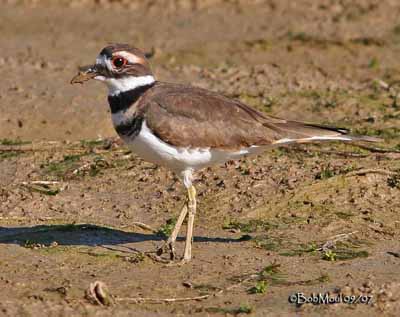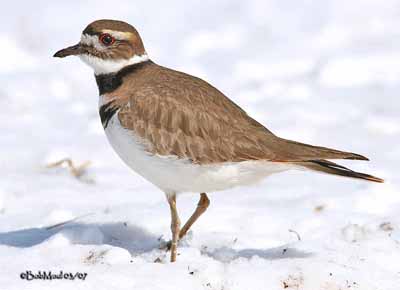
PROTECTION / THREATS / STATUS:
The Killdeer’ populations are stable in N America after an important decline in the 19th century, due to heavy hunting. It is relatively common in Mexico.
This species is not threatened at this moment, taking advantage from human modified habitats.
Fr: Pluvier kildir
All : Keilschwanz-Regenpfeifer
Esp : Chorlitejo Culirrojo
Ital : Corriere americano
Nd: Killdeerplevier
Sd: Skrikstrandpipare
Photographers:
René Lortie
http://rlortie.ca
Bob Moul
Nature Photography
Texte de Nicole Bouglouan
Sources:
HANDBOOK OF THE BIRDS OF THE WORLD Volume 3 by Josep del Hoyo-Andrew Elliott-Jordi Sargatal - Lynx Edicions - ISBN : 8487334202
SHOREBIRDS by Peter Hayman, John Marchant and Tony Prater – Christopher Helm – 1986 – ISBN: 0747014035
GUIDE DES LIMICOLES de D. Taylor - Delachaux et Niestlé - ISBN : 2603014080
A GUIDE TO THE BIRDS OF COLOMBIA by Steven L. Hilty and William L. Brown - Princeton University Press – ISBN 069108372X
A GUIDE TO THE BIRDS OF MEXICO AND NORTHERN CENTRAL AMERICA by Steve N. G. Howell, Sophie Webb - Oxford University Press - ISBN: 0198540124
All About Birds (Cornell Lab of Ornithology)
What Bird-The ultimate Bird Guide (Mitchell Waite)
Killdeer
Charadrius vociferus
Charadriiforme Order – Charadriidae Family
BIOMETRICS:
Length: 23-26 cm
Wingspan: 59-63 cm
Weight: 72-93 g
DESCRIPTION:
The Killdeer is a large plover, unmistakable with the double black breast band and the long tail.

Adult in breeding plumage has brown upperparts with rufous-fringed feathers. Rump and uppertail-coverts are bright orange-brown. The upperwing shows a conspicuous white wing bar well visible in flight. The long tail is grey with white edges. We can see a broad black subterminal bar and a buff tip, except on the outer rectrices which are tipped white.
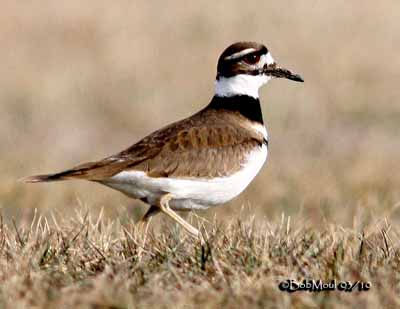
Underparts are white. A conspicuous double black breast band makes this bird easy to identify. The upper bar joins the nape, forming a collar. Chin and throat are white, extending to the nape too, above the black collar.
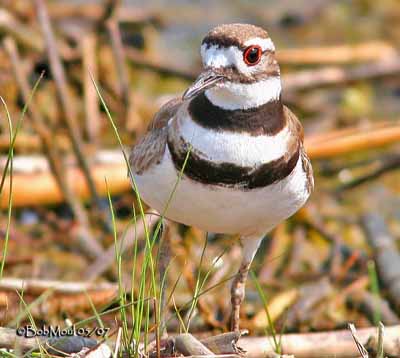
On the head, crown and upper nape are brown. The forehead is white, bordered above by a fine black stripe, extending above the eye. We can see a conspicuous white surpercilium. Another blackish line runs from the bill base through the cheeks and ends on the nape. Ear-coverts are white and brown.
The bill is black. Eyes are dark brown, surrounded by bright red eye-ring. Legs and feet are pale yellowish.
The female has similar plumage, but with browner mask and breast bands.
The adult non-breeding shows rufous and buffy-brown edges on the upperparts.
The juvenile is duller than the non-breeding adult.
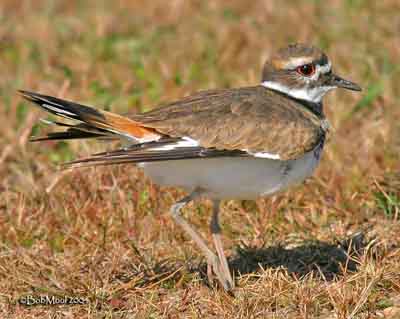
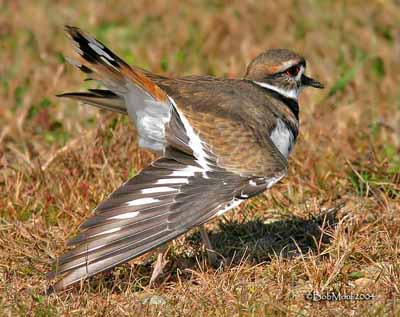
We can find three subspecies:
C.v. vociferus here displayed is found in Canada, United States and Mexico. It winters southwards to NW South America.
C.v. ternominatus occurs in the Greater Antilles. This one is smaller, greyer and paler than nominate.
C.v. peruvianus is found in Peru and NW Chile. This one is smaller than “vociferous”, and shows more extensive rufous fringes on the upperparts.
VOICE: SOUNDS BY XENO-CANTO
The Killdeer’s name comes from its typical call” kill-dee” or “kill-diir kill-diir”. This loud, rapid and repeated call is usually given during the courtship displays.
The alarm call is a dry “dii” or “tir-iiii”.
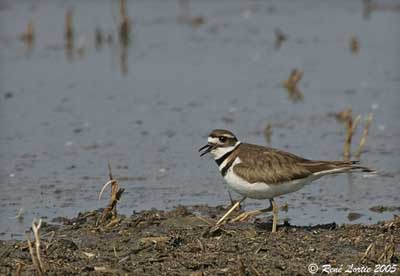
HABITAT:
The Killdeer frequents open fields with short vegetation, and not necessarily close to the water, and it is also seen in open cultivated areas.
This species breeds in sparsely vegetated savannas, in grassy areas such as meadows and pastures, golf courses, bare gravel or roadside ditches, mainly in lowlands and sometimes in great numbers.
During the migrations, the Killdeer can occur in estuaries and other wetland habitats, along rivers, beaches, mudflats and wet grasslands.
This bird can be common near habitations, and some birds may nest on the flat, gravelled roofs.
RANGE:
See above in “subspecies”.
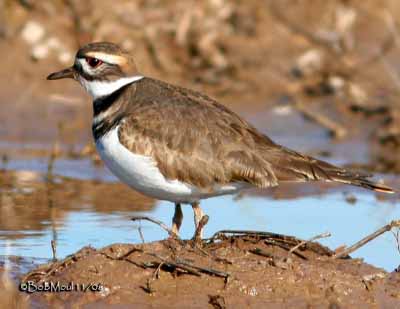
BEHAVIOUR:
The Killdeer feeds on numerous insects’ species, and also takes worms and snails, spiders and crustaceans and some seeds. It frequently uses the “foot-trembling”, even on the ground, to disturb the preys. This species is active by day and by night, and is usually seen alone or in pairs or in small groups outside the breeding period, but never in large flocks.
It hunts by running, stops to catch a prey, and runs again.
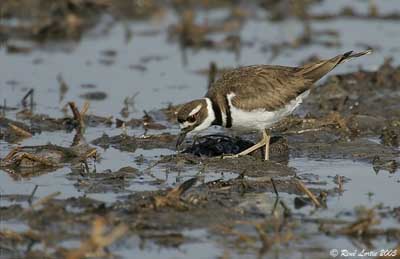
During the breeding season, the Killdeer performs courtship displays, as well aerial as terrestrial. The flight displays show both mates hovering together high in the air, or performing a butterfly-like flight on stiff wings with slow wing-beats. These displays are accompanied with loud, characteristic calls.
On the ground, male and female perform distraction displays to chase away from the nest-site all the intruders. They display the conspicuous bright orange-brown rump and uppertail-coverts by bowing forwards and fanning the tail feathers.
This display is also used as courtship.
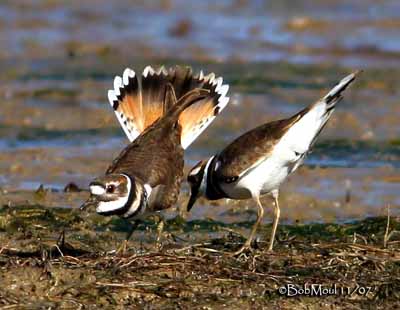
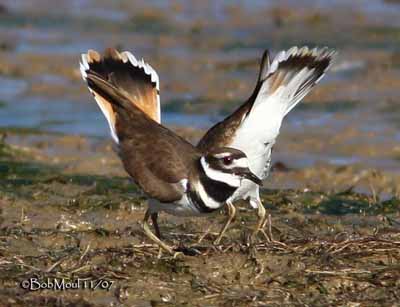
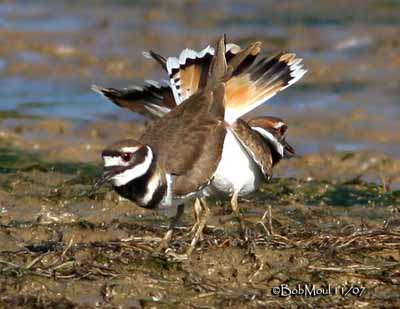
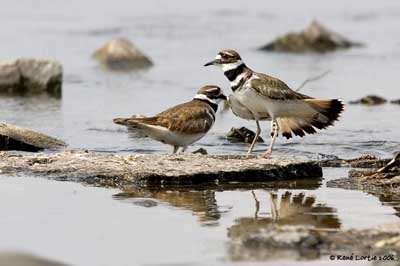
The Killdeer of races “ternominatus” and “peruvianus” are probably resident. The nominate race “vociferus” is migratory, and moves southwards to the wintering areas in Central America, West Indies, Colombia, Ecuador and islands off Venezuela.
The birds follow the coasts, but they also fly in broad front over land. They migrate by night.
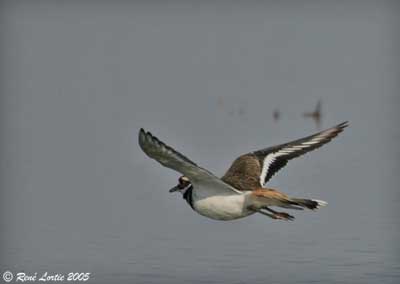
FLIGHT:
The Killdeer performs slow, graceful flight, and travels in erratic wavering manner.
The bright rump and uppertail-coverts are conspicuous in flight, as the white wing-bar.
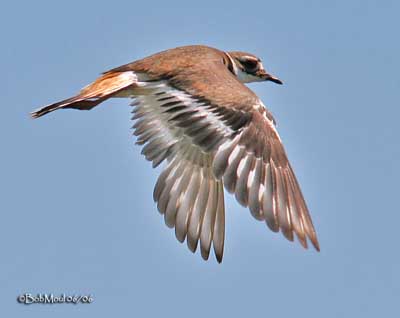
REPRODUCTION:
The Killdeer is seasonally monogamous. The breeding season occurs between March and June in South, and from mid-April to mid-July in North.
The nest is placed on the ground. It is a shallow scrape with lining of vegetation or stones or nothing. The nest-site is situated in exposed bare or sparsely vegetated area, and mainly on gravels or stones.
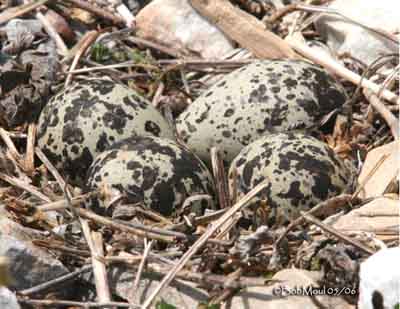
The female lays four cryptically coloured eggs at 1-2 days intervals. The incubation lasts about 24-28 days, shared by both parents. One to three replacement clutches may occur if the eggs are lost.
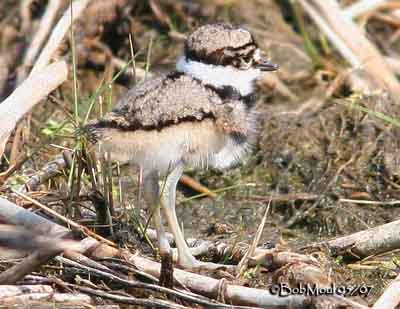
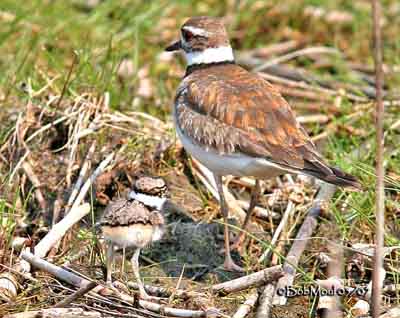
The precocial chicks are tended by both adults and fledge one month later. They often remain with their parents during ten days before to be independent. They are sexually mature at one year old.

DIET:
The Killdeer feeds mainly on insects such as beetles, flies, grasshoppers, caterpillars, dragonflies and numerous other species. It also takes worms and snails, spiders, crustaceans and some seeds.
